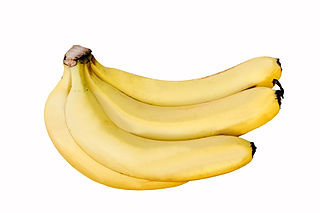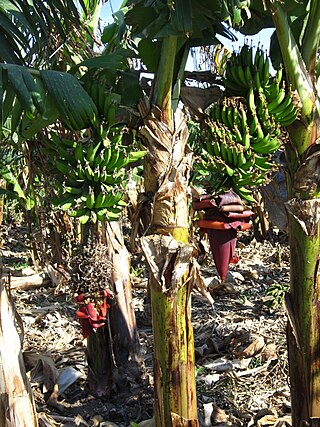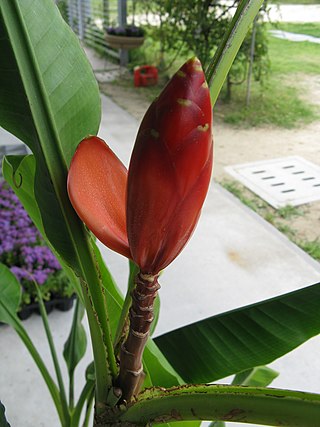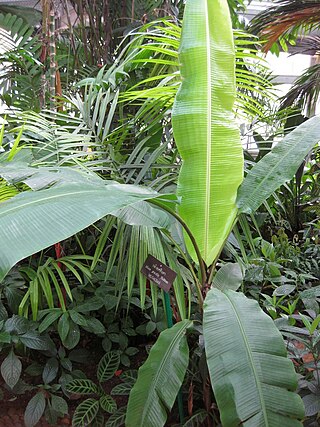
A banana is an elongated, edible fruit – botanically a berry – produced by several kinds of large herbaceous flowering plants in the genus Musa. In some countries, bananas used for cooking may be called "plantains", distinguishing them from dessert bananas. The fruit is variable in size, color, and firmness, but is usually elongated and curved, with soft flesh rich in starch covered with a rind, which may be green, yellow, red, purple, or brown when ripe. The fruits grow upward in clusters near the top of the plant. Almost all modern edible seedless (parthenocarp) bananas come from two wild species – Musa acuminata and Musa balbisiana. The scientific names of most cultivated bananas are Musa acuminata, Musa balbisiana, and Musa × paradisiaca for the hybrid Musa acuminata × M. balbisiana, depending on their genomic constitution. The old scientific name for this hybrid, Musa sapientum, is no longer used.

Nicholai Nikolaevich Miklouho-Maclay was a Russian explorer. He worked as an ethnologist, anthropologist and biologist who became famous as one of the earliest scientists to settle among and study indigenous people of New Guinea "who had never seen a European".

The blood banana, is a variety of the wild banana Musa acuminata native to Sumatra, Indonesia. The blood banana is an ornamental plant, named for the dark red patches on its leaves, though its small-seeded fruits are also edible. It grows 6' to 8' tall in the wild, but is well-adapted to container growing and can be maintained at 3' to 5'. It grows best in full or partial sun and is hardy in zones 9 - 11.

Musa is one of three genera in the family Musaceae. The genus includes 83 species of flowering plants producing edible bananas and plantains. Though they grow as high as trees, banana and plantain plants are not woody and their apparent "stem" is made up of the bases of the huge leaf stalks. Thus, they are technically gigantic herbaceous plants. Musa species are used as food plants by the larvae of some Lepidoptera species, including the giant leopard moth and other Hypercompe species, including H. albescens, H. eridanus, and H. icasia.

Cavendish bananas are the fruits of one of a number of banana cultivars belonging to the Cavendish subgroup of the AAA banana cultivar group. The same term is also used to describe the plants on which the bananas grow.

The Grand Nain banana is a banana cultivar of Musa acuminata. It is one of the most commonly cultivated bananas and a member of the commercial Cavendish banana cultivar group. It is also known as the Chiquita banana because it is the main product of Chiquita Brands International.

Musa acuminata is a species of banana native to Southern Asia, its range comprising the Indian Subcontinent and Southeast Asia. Many of the modern edible dessert bananas are from this species, although some are hybrids with Musa balbisiana. First cultivated by humans around 10 kya, it is one of the early examples of domesticated plants.

Saba banana, is a triploid hybrid (ABB) banana cultivar originating from the Philippines. It is primarily a cooking banana, though it can also be eaten raw. It is one of the most important banana varieties in Philippine cuisine. It is also sometimes known as the "cardaba banana", though the latter name is more correctly applied to the cardava, a very similar cultivar also classified within the saba subgroup.

Fe'i bananas are cultivated plants in the genus Musa, used mainly for their fruit. Unlike most other cultivated bananas they are diploids of the AA-type. They are very distinct in appearance and origin from the majority of bananas and plantains currently grown. Found mainly in the islands of the Pacific, particularly French Polynesia, Fe'i bananas have skins which are brilliant orange to red in colour with yellow or orange flesh inside. They are usually eaten cooked and have been an important food for Pacific Islanders, moving with them as they migrated across the ocean. Most are high in beta-carotene.

Señorita bananas are diploid cultivars of the banana Musa acuminata originating in the Philippines. They are very small stout bananas which, like all bananas belonging to the AA cultivar group, are known for being extraordinarily sweet.

Musa coccinea, commonly known as scarlet banana or red-flowering banana, is a species of flowering plant in the banana and plantain family Musaceae, native to tropical China and Vietnam. It is a bat-pollinated evergreen perennial, placed in section Callimusa, having a diploid chromosome number of 2n = 20.

Musa × paradisiaca is the accepted name for the hybrid between Musa acuminata and Musa balbisiana. Most cultivated bananas and plantains are triploid cultivars either of this hybrid or of M. acuminata alone. Linnaeus originally used the name M. paradisiaca only for plantains or cooking bananas, but the modern usage includes hybrid cultivars used both for cooking and as dessert bananas. Linnaeus's name for dessert bananas, Musa sapientum, is thus a synonym of Musa × paradisiaca.

Musa beccarii is a species of wild banana, found in Malaysia, in Sabah. It is placed in section Callimusa.

Musa jackeyi is a species of wild banana in the Banana Family (Musaceae).. It is placed in section Callimusa. It has only a small native range in north-east Queensland, Australia. It is the second tallest banana species after Musa ingens, having petioles (stalks) up to 33 ft (10 m) in height, topped by laminae (blades) 14.5 ft (4.4 m) long by 2 ft (61 cm) in width, for a total height of up to 47.5 ft (14.5 m). It resembles the cultivated bananas called "fe'i" or "fehi", having an upright rather than a drooping fruit stalk, with the green terminal bud pointing upwards, and sap which is reddish in colour.
Musa boman is a species of wild banana, native to the West Sepik (Sandaun) Province of Papua New Guinea, in the eastern portion of the island of New Guinea. It is placed in section Callimusa, having a diploid chromosome number of 2n = 20. The male bud is cream in colour.
Musa exotica is a species of wild banana, native to Vietnam. It is placed in section Callimusa, having a diploid chromosome number of 2n = 20. It was only described in 2004, from a collection in the Cúc Phương Forest Reservation, Ninh Bình Province, Vietnam. The clear orange bud is upright; small yellow bananas develop below the male flowers.

Musa gracilis is a species of wild banana, native to Peninsular Malaysia. It is placed in section Callimusa, having a diploid chromosome number of 2n = 20. It grows to less than 2 m (7 ft) tall. It has an upright pink-purple bud and produces narrow fruits (bananas), which have magenta and green stripes.

Musa lolodensis is a species of wild banana, occurring naturally from the Moluccas through to New Guinea. It is placed in section Callimusa, having a diploid chromosome number of 2n = 20. It is one of the possible parents of the cultivated Fe'i bananas.
Musa peekelii is a species of wild banana, native to eastern New Guinea and the Bismarck Archipelago. It is placed in section Callimusa, members of which have a diploid chromosome number of 2n = 20. It is a very tall plant, reaching over 10 m (33 ft), with a narrow green drooping bud. The ripe bananas are red with bright yellow flesh. It is one of the possible parents of the cultivated Fe'i bananas.
















